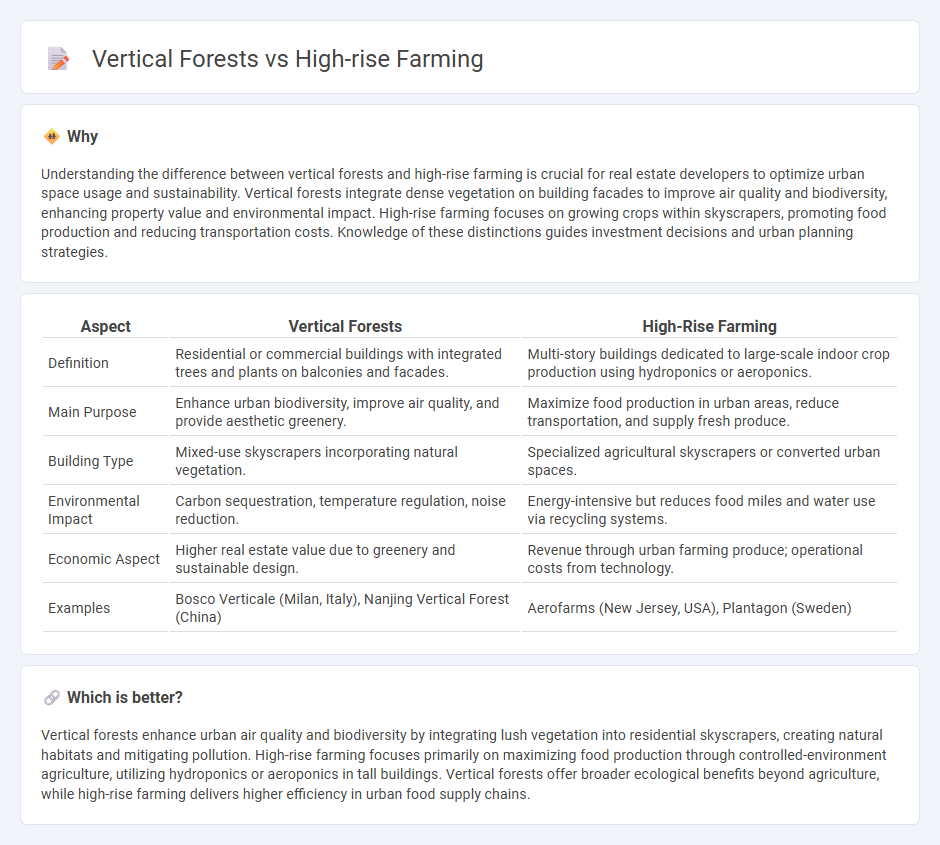
Vertical forests integrate dense vegetation on building facades, improving urban air quality and biodiversity, while high-rise farming focuses on maximizing indoor crop production within skyscrapers to enhance food security in cities. Both approaches address sustainability challenges in urban real estate by transforming conventional structures into multifunctional ecosystems. Explore how these innovative models are reshaping future city living and real estate development.
Why it is important
Understanding the difference between vertical forests and high-rise farming is crucial for real estate developers to optimize urban space usage and sustainability. Vertical forests integrate dense vegetation on building facades to improve air quality and biodiversity, enhancing property value and environmental impact. High-rise farming focuses on growing crops within skyscrapers, promoting food production and reducing transportation costs. Knowledge of these distinctions guides investment decisions and urban planning strategies.
Comparison Table
| Aspect | Vertical Forests | High-Rise Farming |
|---|---|---|
| Definition | Residential or commercial buildings with integrated trees and plants on balconies and facades. | Multi-story buildings dedicated to large-scale indoor crop production using hydroponics or aeroponics. |
| Main Purpose | Enhance urban biodiversity, improve air quality, and provide aesthetic greenery. | Maximize food production in urban areas, reduce transportation, and supply fresh produce. |
| Building Type | Mixed-use skyscrapers incorporating natural vegetation. | Specialized agricultural skyscrapers or converted urban spaces. |
| Environmental Impact | Carbon sequestration, temperature regulation, noise reduction. | Energy-intensive but reduces food miles and water use via recycling systems. |
| Economic Aspect | Higher real estate value due to greenery and sustainable design. | Revenue through urban farming produce; operational costs from technology. |
| Examples | Bosco Verticale (Milan, Italy), Nanjing Vertical Forest (China) | Aerofarms (New Jersey, USA), Plantagon (Sweden) |
Which is better?
Vertical forests enhance urban air quality and biodiversity by integrating lush vegetation into residential skyscrapers, creating natural habitats and mitigating pollution. High-rise farming focuses primarily on maximizing food production through controlled-environment agriculture, utilizing hydroponics or aeroponics in tall buildings. Vertical forests offer broader ecological benefits beyond agriculture, while high-rise farming delivers higher efficiency in urban food supply chains.
Connection
Vertical forests and high-rise farming intersect by integrating greenery and food production into urban skyscraper designs, enhancing sustainability. Both concepts utilize vertical space to combat urban sprawl, improve air quality, and promote biodiversity within metropolitan areas. Implementing these green infrastructures supports environmental resilience and offers a viable solution to food security challenges in densely populated cities.
Key Terms
Building Density
High-rise farming maximizes building density by integrating agricultural spaces within tall structures, promoting urban food production while conserving land area. Vertical forests increase building density through the incorporation of extensive vegetation on residential towers, enhancing air quality and biodiversity in dense urban environments. Discover more about how these innovative approaches transform urban landscapes and sustainability.
Green Façade Integration
High-rise farming and vertical forests both contribute to urban greening but differ in their integration of green facades; high-rise farming emphasizes agricultural productivity through hydroponic or soil-based systems on building exteriors, while vertical forests prioritize biodiversity with integrated tree and plant ecosystems on balconies and facades. Green facade integration in high-rise farming focuses on optimizing crop growth and food production, whereas vertical forests aim to enhance air quality, sequester carbon, and provide habitat for urban wildlife. Explore how these innovative green facade strategies transform sustainable urban development and climate resilience.
Urban Sustainability
High-rise farming utilizes multi-story buildings to grow crops using hydroponics or aeroponics, significantly reducing land use and water consumption while enhancing urban food security. Vertical forests integrate trees and vegetation on building facades, improving air quality, reducing urban heat islands, and promoting biodiversity within cities. Explore how these innovative approaches drive urban sustainability and transform city landscapes.
Source and External Links
The Integration of Vertical Farms Into Urban High-Rises - High-rise farming, exemplified by Singapore's Sky Greens, involves vertical farms integrated into urban high-rises using innovative, low-energy systems like hydraulic-driven rotating towers to maximize sunlight and water efficiency while producing fresh vegetables sustainably.
Vertical farming - Wikipedia - Vertical farming grows crops in vertically stacked layers often with controlled-environment agriculture, but is challenged by high energy demands for supplemental lighting, heating, and cooling, which can make it uncompetitive with traditional farming methods.
Skyscraper Farm: Vertical Farming | Mixed-Use Real Estate - Skyscraper Farm combines vertical farming with mixed-use real estate, offering designs from four-story farms to 52-story skyscrapers that integrate farming with residential and commercial spaces to sustainably produce food close to urban populations.
 dowidth.com
dowidth.com